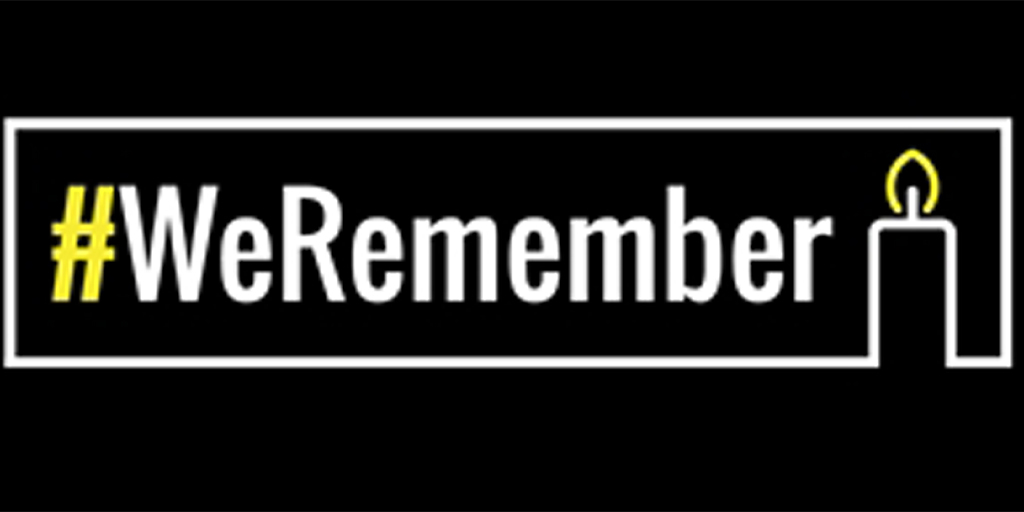
We Remember on Social Media
If the core logics of social media are the sharing economy and the attention economy, it is significant to study what content has the most interactions and shares on Holocaust Memorial Day, if we are to understand the spreadability of awareness campaigns.
In our first post of 2022, we offer some very early findings regarding popular social media content this Holocaust Memorial Day.
Holocaust Memorial Day and Social Media
Since the UN Resolution 60/7 in 2005, the 27th January has been recognised internationally as Holocaust Memorial Day. This date commemorates the liberation of Auschwitz by the Soviet forces in 1945, but is used to reflect on all Holocaust victims and in some cases (such as in the UK), genocide victims more broadly.
The Holocaust Memorial Day Trust (HMDT) in the UK run a major national campaign, supporting commemorations with resources and making visible the vast range of local and national level events. This year’s theme was Light in the Darkness.
More internationally, in 2022, UNESCO and the World Jewish Congress worked with major social media platforms, such as Twitter, Facebook, Instagram and TikTok through advertising grants to highlight content related to their #WeRemember campaign. You can hear representatives from UNESCO and the WJC talk more about the project at a recent UN Civil Society Briefing here.
The significance that social media plays in public memory and understanding of the Holocaust has in recent years been taken more seriously, as the significance of online distortion and denial has been recognised. As early as 2014, The International Holocaust Remembrance Alliance published guidelines for Holocaust Educators using social media. Nevertheless, there is still evidently a deficiency in digital literacies and capacities in Holocaust education and memory contexts.
Methodology
It was possible to collect an internationally-relevant sample of posts from Facebook, Instagram and Twitter through researcher access to their APIs: CrowdTangle for the Meta-owned platforms and then Twitter’s API 2.0 for the latter.
We combined our own knowledge of common phrases used for Holocaust remembrance, such as #NeverForget and #NeverAgain with terms we found used on posts by official memory organisations and users from an initial manually look on social media on the day. We also added the UNESCO/WJC campaign #WeRemember.
We then collected posts using the following hashtags:
#HMD / #HMD2022
#HolocaustRemembranceDay /#HolocaustRemembranceDay2022
#HolocaustMemorialDay / #HolocaustMemorialDay2022
#NeverAgain
#NeverForget
#WeRemember
The time period set for collection was Wednesday 26th January 12pm – Friday 28th January 12pm UTC, to enable capture of tweets from across time zones.
We combined the produced .csv files for each platform and removed duplicates of posts which used more than one of these hashtags.
For these initial findings, we simply used the ‘sort’ function to get top results of Total Interactions (Facebook/Instagram) and Retweets (Twitter).
It is important to note the limitations of institutional APIs: Facebook/Instagram only give access to public profile posts (and public groups, but we focused on the former here) and Twitter only gives access to public tweets.
TikTok does not yet give researchers access to its API, therefore a different – manual – methodology would be needed here. There are plans for a future post about Holocaust Memorial Day on TikTok, but given the different approach needed, we’ve left it out of this piece.
What Did We Find?
Each platform presented different results in terms of its top posts. For the sake of brevity here, we present the top 5 on each site.
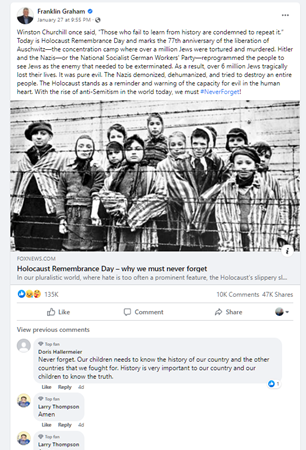
• No.1: Franklin Graham – American Evangelist and missionary shares a Fox News story about the Holocaust. Total Interactions: 192,509. Likes: 70,743. Comments: 10,150. Shares: 46,028
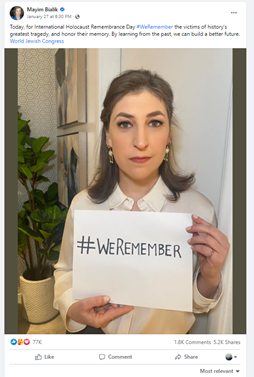
No.2: Actress Mayim Bailik (Blossom, the Big Bang Theory) participates in the #WeRemember campaign. Total Interactions: 84,584. Likes: 38,944. Comments: 1,804. Shares: 5,243.
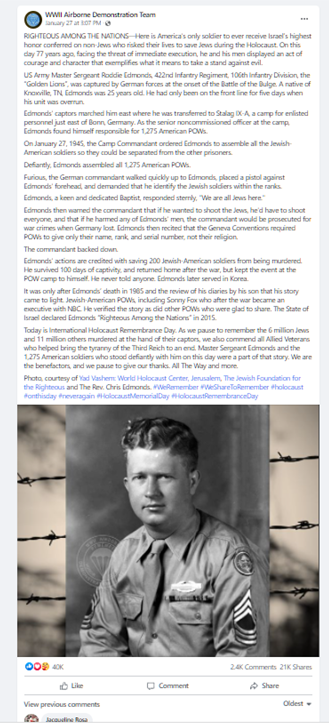
No.3: WII Airborne Demonstration – an organisation remembering veterans of WWII presents a story of an American soldier commemorated as one of the ‘Righteous Among the Nations’. Total Interactions: 64,939. Likes: 26,968. Comments: 2,475. Shares: 21,787.
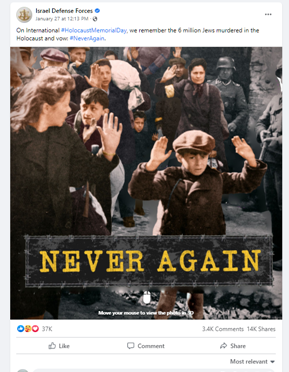
No. 4: Israel Defense Forces share a colourised version of the historic image of the young boy during liquidation of the ghetto with Never Again posted over the image. Total Interactions: 54,697. Likes: 22,445. Comments: 3,446. Shares: 14,090
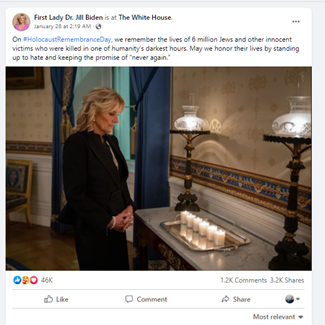
No5: First Lady, Dr. Jill Biden offers reflections for HMD. Total Interactions: 51,071. Likes: 23,031. Comments: 1,265. Shares: 3,246.
The top 5 on Facebook is dominated by normative ideological engagement with Holocaust memory, either situating it within religious rhetoric, military contextualisation (both the allied saviour narrative and connecting it with the need for Israeli defence) or the presentation of a Political figure (Dr. Biden) partaking in commemoration. The only post which resists this is that by American-Jewish actress Mayim Bailik sharing a #WeRemember banner.
The difference in total interactions between Franklin Graham’s post at no.1 and Mayim Bailik’s at no.2 is more than double. The top post, by an American evangelist and missionary sharing a story from Fox News is almost as popular on its own as the next 3 posts combined. When the posts were sorted by ‘angry face’ responses, Graham’s appeared 2nd on the list, suggesting controversy still rules on Facebook (even though the post itself is not controversial).
Looking at the wider data set, the only memorial museums, sites or Holocaust education organisations to feature in the top 20 are Museum of Jewish Heritage – A Living Memorial to the Holocaust (no. 7), the Anne Frank House (no. 8 and 9), and the United States Holocaust Memorial Museum (no. 20).
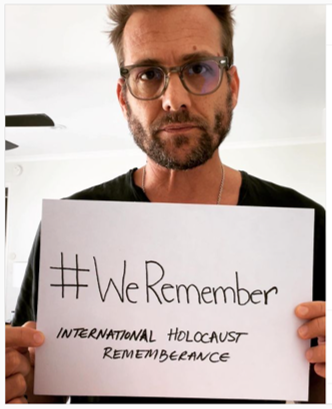
No. 1 Suits’ actor Gabriel Macht joins the #WeRemember campaign. Total Interactions: 192,423. Total Likes: 190,729. Comments: 1,694.
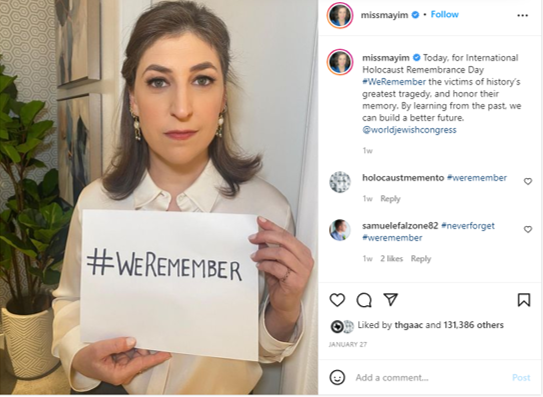
No. 2 We see actress Mayim Bialik again holding up her #WeRemember sign. Total Interactions: 132,922. Total Likes: 131,371. Total Comments: 11,551.
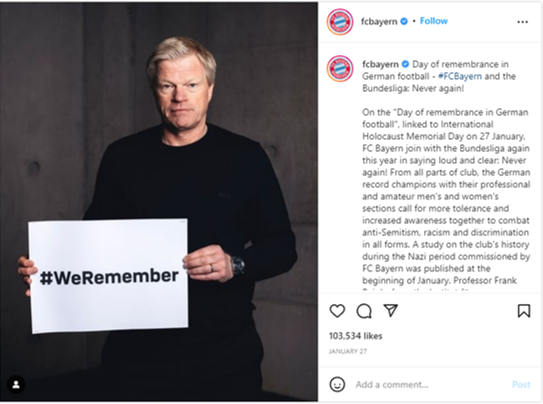
No 3. FC Bayern shares its support for the #WeRemember campaign too. Total Interactions: 104,131. Total Likes: 103,518. Total Comments: 613.
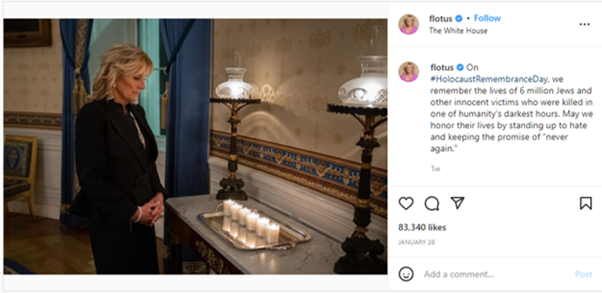
No. 4 Also popular on both Instagram and Facebook is Jill Biden (like Mayim). Total Interactions: 84,181. Total Likes: 83,341. Total Comments: 840.
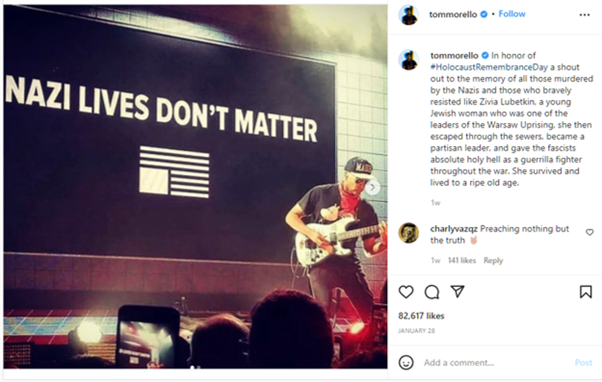
No. 5 American musician and political activist, best known for his involvement with Rage Against the Machine and Audioslave posts with an arguably controversial image saying ‘Nazi Lives Don’t Matter’ not only appropriating #BLM rhetoric, but also implicitly calling for the murder of humans on HMD. Total Interactions: 83,559. Total Likes: 82,615. Comments: 944.
In contrast with Facebook, the top 5 on Instagram is dominated by celebrities. Mayim and Dr. Biden both surfaced in this list as well as on Facebook. Performers and a German football team actively show their support for the #WeRemember campaign here. In place #4 and #5 are more political posts: both Biden’s and one from Tom Morello, renown for political activism in his music and words. The ‘Nazi Lives Don’t Matter’ banner in the background of his image, however, seems controversial both in being implicitly a call to violence, and in appropriating a specific campaign #BlackLivesMatter for a commemoration event concerned with different histories. Nazi persecution indeed affected Black Germans, however this particular group in that specific historical time is not the focus of the Black Lives Matter movement.
No Holocaust institutions feature in the top 20 posts on Instagram, with the United States Holocaust Memorial Museum appeared at no. 22. However, @Standwithus a non-profit organisation which describes itself as ‘Fighting Antisemitism and Supporting Israel Around the World’ has posts at #12 and #15.
Popular rhetoric on Instagram on Holocaust Memorial Day seems far more centred on activism and campaigns compared to Facebook, where the top posts are more commonly situated in normative ideological contexts.
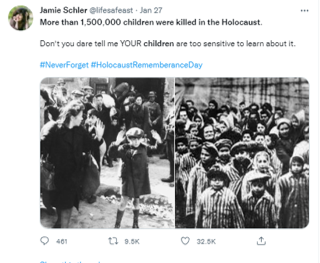
No. 1 Cookbook and food author, podcaster Jamie Schler offers a post which seems to implicitly reflect on the controversy of the banning of Maus with the line ‘don’t tell me YOUR children are too sensitive’ to learn about this history. The post was retweeted 9,029 times.
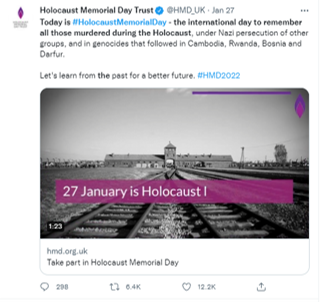
No 2. An official post from the Holocaust Memorial Day Trust, retweeted approximately two 3rds less than Schler’s at 5,891.
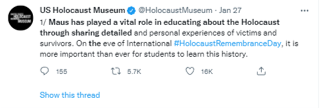
No. 3 The United States Holocaust Memorial Museum comments on the controversial banning of Maus in some US schools. Retweets: 5,700.
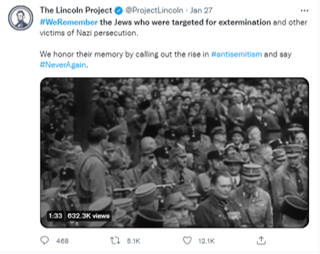
No. 4 A commemorative post from ‘The Lincoln Project’, established by a group of Republicans who want to prevent the re-election of Trump. Retweets: 4,364.

No 5 Aaron Parnas – who describes himself as ‘a Proud Miamian, White Collar Attorney and Gen Z Democratic Strategist’ and co-host of @ZoomedInPodcast and Jewish shares a tweet which highlights the scale of the Holocaust. Retweets: 4,306.
Twitter is the one space where we do see major Holocaust organisations in the top 5. In the top 20, we see both HMD_UK (#16) and the USHMM again (#20) and the Auschwitz Memorial Museum (#11).
We again see some evidence of the politicisation of Holocaust memory here, although only one post.
We have the same number of posts appearing from Holocaust organisations as we do from more minor public figures: Schler a cookbook and food writer with a new podcast, and Parnas, whose co-hosted podcast has a modest 2,000+ followers on Twitter. Both individuals have substantial followers on Twitter, however, Schler (54.3K) and Parnas (173K).
There is so many much more to read in this rich data set. However, we hope that this brief and (almost) immediate post provides a first glimpse of the ways in which the affordances of these different social media platforms are used for Holocaust commemoration.